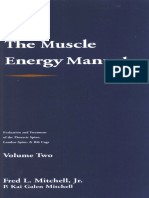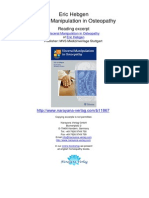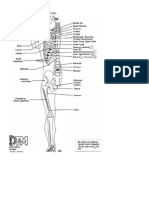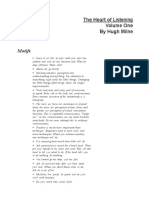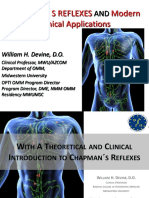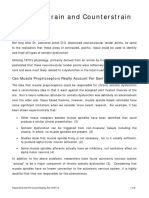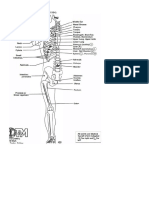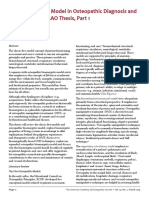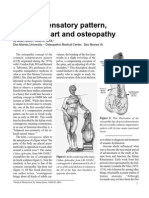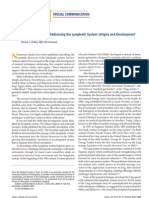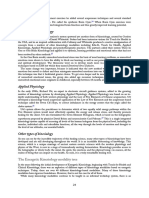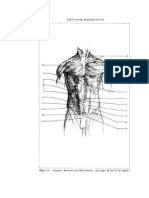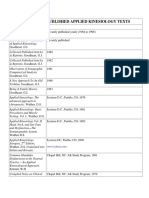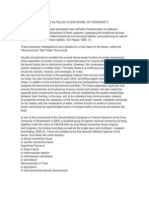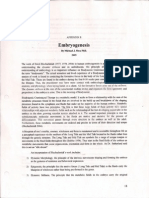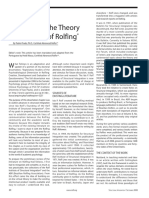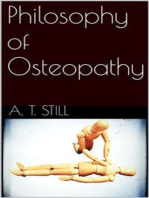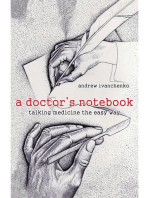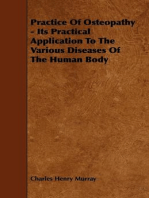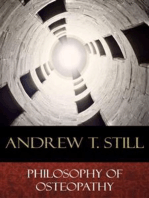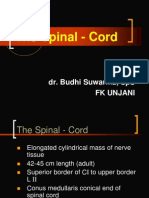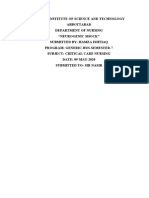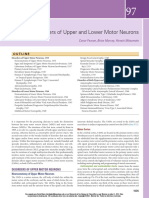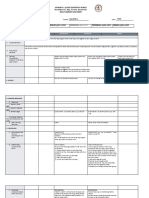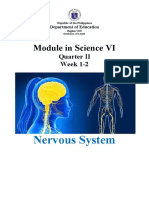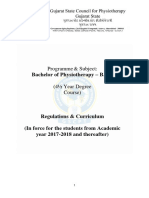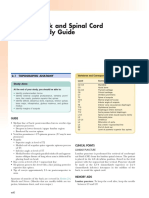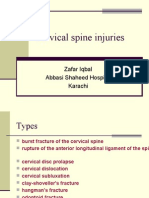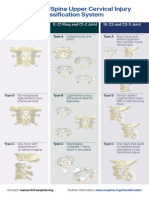Facilitated Segments
Facilitated Segments
Uploaded by
ismaelvara6568Copyright:
Available Formats
Facilitated Segments
Facilitated Segments
Uploaded by
ismaelvara6568Original Description:
Copyright
Available Formats
Share this document
Did you find this document useful?
Is this content inappropriate?
Copyright:
Available Formats
Facilitated Segments
Facilitated Segments
Uploaded by
ismaelvara6568Copyright:
Available Formats
08/06/2015
FacilitatedSegments
Home|Publications|CPDO,15HarbertonRoad,LondonN193JSUKTl:+44(0)2072638551
FacilitatedSegments:acriticalreview
Keywords:Facilitatedsegments,manualtherapy,osteopathy
The concept of spinal facilitated segments has dominated osteopathic neurophysiology for
over half this century. This concept has been at the heart of osteopathic teachings and is
oftenusedbothinclinicaldiagnosisandaspartoftherationaleoftreatingdifferentmusculo
skeletal and visceral conditions. Surprisingly, such an important subject has never been
criticised: the existence of facilitated segments and their relevance to manual therapy or
osteopathic medicine has never been questioned. This article reexamines the original
studiesofKorr,Denslowandtheircoworkers,aimtoidentifywhathasbeendemonstrated
in these studies and to reinterpret their findings in the light of current knowledge of
neurophysiology.
Thespinalfacilitationconcept
Inprinciple,thefacilitatedsegmentwasdescribedasaspecificareaofthespinalcordthat
wascapableoforganisingdiseaseprocesses.Itwasaverysimplisticmodel:ithadtwoinput
and two output routes. The input routes were sensory from musculoskeletal and viscera.
Theoutputrouteswerethemotorefferentstomuscleandautonomicmotortosweatglands,
bloodvesselsandviscera.Insidethespinalcorditwassuggestedthatabnormalactivityin
oneareaofthespinalcordcouldspreadtoadjacentareas.Thefacilitationprocesswouldbe
initiatedwhenaberrantsensoryinformationfromanareaofdamageorpathology(muscleor
viscera) was conveyed via the afferents to the spinal cord. This would alter the neuronal
activityatthesamesegmentallevelandmightspreadtoadjacentareasofthespinalcord
affecting spinal centres not directly related to the original injury. For example, a
musculoskeletal injury could reach the spinal cord through its afferent connection causing
spinal facilitation or sensitisation to take place. Because of the anatomical proximity of the
motorandautonomicspinalcentres,thisspreadofexcitationwouldeventuallyinvolvethese
lateralcentres.Thisinturnwouldalterthesegmentalautonomicactivityleadingtochanges
in vasomotor, sudomotor and visceral activity. The reverse could happen too: through the
sameneurologicalmechanismsapathologicalconditioninthevisceracouldendupaffecting
skeletalmuscleactivity.
Even before examining the original research, we can see that there are several problems
withthefacilitatedsegmentmodel:
a.Thedescendinginfluencesfromhighercentreswerenotincludedinthemodel,although
theyhaveprofoundsegmentalinfluences.Thisomissionisunrealisticthespinalcentresdo
not work in isolation from the higher centres. Both movement and autonomic activity are
heavilyorganisedfromabovethespinalcord(Sherrington,1906Folkow,1956Bard,1960
Brown,1968Ganong,1981Schmidt,1991).
b. Outside the spinal cord afferent and efferent connections are, anatomically, highly
segmental. However once in the spinal cord all anatomical specificity is lost (Luscher &
Clamann, 1992). Motoneurons of several muscles are intermingled within the ventral horn
anddistributedoverseveralsegmentsupordownfromthepointofexit(efferentperipheral
nerve).Similarlyafferentsfromoneareaormuscle,onceinthespinalcord,tendtodiverge
up and down over several segments terminating on many different motoneurons and
interneurons (Luscher & Clamann, 1992). For example, spindle afferents from one muscle
connectwithmotoneuronsofothermusclegroups(Ecclesetal,1957Eccles&Lundberg,
1958). This implies that if lateral spread of sensitisation does take place, it will not
necessarilybesegmentallyspecific.
c. The facilitation model creates a biological paradox which is not supported either by
data:text/htmlcharset=utf8,%3Ctable%20border%3D%220%22%20cellpadding%3D%220%22%20cellspacing%3D%220%22%20style%3D%22fontfamil
1/6
08/06/2015
FacilitatedSegments
research or by clinical observations. If damage in muscle caused spinal facilitation and
consequentlyvisceraldysfunction,itwouldmeanthateachtimewedamageourmusclesit
wouldautomaticallyresultinsomevisceraldysfunction.Inthisscenariocommonconditions,
suchasdelayedonsetmusclesorenesswhichisassociatedwithmuscledamage(Bobbetet
al, 1986 Ebbeling & Clarckson, 1989), would inevitably lead to visceral dysfunction. Yet,
'viscerally' speaking, most sports people are fairly healthy. They do not seem to develop
visceraldysfunctioninresponsetoacuteorchronicmusculoskeletalconditions.
Theoriginalresearch
Korr, Denslow and their coworkers were the first to describe the facilitated segments in
osteopathicmedicine.Theoriginalresearchconsistedofseveralstudieswhichwerecarried
outonalargenumberofnormalhealthysubjects.Theyuseddifferentexperimentalsetups
andwereabletodemonstratethefollowingfindings:
1.Varyingmotorthresholdspressureoverthespinousprocessesproducedreflexmuscle
contractionatandclosetothesegment.Insomesegmentsthisresponsewasexaggerated
(Denslowetal,1947).Everypersonhadanindividualpatternofresponse.
2.Varyinglevelsofskinconductivitythereweredifferencesinthesweatingpatternofthe
backs of all normal individuals (Korr et al, 1958). This suggests increased activity of the
sweatgland,implyingalteredsympatheticactivity.
3.Varyinglevelsofvasomotoractivityusingtemperatureandlightsensorstheywereable
todemonstratethatallnormalsubjectshaveindividualvasomotoractivitywhichischanged
indifferentpartsoftheback(Wrightetal,1960).
4.Viscerosomaticchangessometimes,knownvisceralpathologiesmanifestedsegmentally
asincreasedskinconductivity(Korretal,1964).
5.Eachindividualhadauniquethermalpatternwithsomecommonpatternssharedbyall
normalsubjects(Wright&Korr,1965).
Contrarytocommonlyheldbelief,theydidnotdemonstratethefollowing:
1.Theydidnotshowfacilitationmostofthestudieswerecarriedoutonnormalhealthy
subjects. In all subjects they found varying levels of neurological activity at different
segmentallevels.Thisisacomplexsituationtobeginwith:ifthesubjectswerehealthyhow
cometheyalldisplayedasupposedlyneuropathologicalstateoffacilitation?Ifthebiological
normisthathealthysubjectsallshowsignsoffacilitation,itimpliesthattheregionalchanges
observedprobablyrepresentthenormalvariabilityofahighlycomplexsystemratherthana
facilitation phenomenon. Such variability can be demonstrated anywhere in the body. For
example, if you prod different parts of your own leg, you will find some areas are more
tender, with the muscles feeling stiffer, and if you press hard enough you may make the
muscle contract to evade pain and discomfort. When this procedure was applied to the
spine,asDenslowetal(1947)did,itwasveryattractivetoviewitassegmentalfacilitation.
Spinal facilitation does occur and can be seen following musculoskeletal injuries. It is well
established that inflammation produces both peripheral sensitisation of the afferents (such
asfreenerveendings)andcentralsensitisationwithinthespinalcord(Dunbar&Ruda1992,
Hyldenetal1989,Cooketal1987,Woolf&Walters1991).Thissensitisationmeansthatthe
threshold of different neurons is reduced, so they respond to mechanical stimuli to which
they were impervious before injury. This process tends to spread laterally in the spinal
cord but in a selective way not all neurons are sensitised. The selectivity of the spread
seems to be functional in character supporting the process in some way. For example,
lateralsensitisationhasbeenshowntospreadtothemotoneuronswhichsupplythemuscles
intheaffectedarea(Heetal,1988).Thismayhaveafunctionalroleinthemuscleguarding
often observed at the site of damage. It is very difficult to imagine what would be the
functionalroleofalateralspreadtoautonomicvisceralcentresinmusculoskeletaldamage.
It should also be noted that the sensitisation process seems only to take place when
nociceptorsareexcitedbypainorinflammationandnotwhenproprioceptorsarestimulated,
data:text/htmlcharset=utf8,%3Ctable%20border%3D%220%22%20cellpadding%3D%220%22%20cellspacing%3D%220%22%20style%3D%22fontfamil
2/6
08/06/2015
FacilitatedSegments
suchasduringamanualtreatment.
A similar sensitisation phenomenon was demonstrated by Korr and his coworkers (1962),
by introducing chemical insults to different spinal structures. They demonstrated that this
lateral spread could alter sympathetic activity to the segmental sweat glands. This change
only took place when pain was inflicted. However, the spread was not always 'neatly'
segmental some of the changes were general or remote from the segmental distribution.
This finding is not surprising in the light of what has been discussed about afferent
divergencewithinthespinalcord.Thesechangesinsympatheticactivitymaynotnecessarily
have been due to facilitation. They may arise as a secondary functional physiological
process,e.g.tosupportchangesinmuscleactivityortheinflammationprocessatthesiteof
damage. Furthermore, such sympathetic changes in sudomotor activity have no clinical
relevance to osteopathic practice. More important clinically are changes in motoneuron
thresholdbyspinalsensitisationasdescribedbyHeetal(1988).
WhenKorretal(1962)introducedposturalinsults,suchasheelliftsononeside,orhaving
the subjects sit on a tilted chair, they observed changes in the pattern of sweating. The
changes were general but sometimes more noticeable as an exaggeration of the pattern
observed before the insult. Again, they concluded that these changes were due to
facilitation. However this is also doubtful: the changes were probably due to whole body
adjustmentstochangesinpostureratherthanalocallyorganisedchangeinthespinalcord.
Heretoothelegcanbeusedasanexample.Ifyouaskasubjecttostandononelegthere
willbeconsiderabledifferencesinthemuscleactivitiesofthetwolegs.Naturallytheblood
supply and sweat gland activity will also vary considerably between the two legs with an
increase in activity in the balancing leg. These are whole body postural adjustments
incorporatingcomplexpatternsofneuromuscularandsupportiveautonomicchanges.These
patternsofrecruitmentareorganisedwithinthewholesystemratherthensegmentallybythe
limitedandlocalprocessesoffacilitation.
All the changes that were demonstrated were during separate studies on different
individuals: one study showed that in normal subjects there may be a variable pattern of
muscleresponsetopressure(Denslow,1947).Anothershowedchangesinskinconductivity
(Price&Korr,1957),andathirdshowedvariabilityofvasomotortone(Wright&Korr,1960).
Theynevertookthelogicalstepofexaminingallthreephenomenaoffacilitationinthesame
group of subjects! This is equivalent to seeing three different patients, one with joint pain,
onewithconjunctivitisandanotherwithurethritis,anddiagnosingthemallashavingReiter's
Syndrome!Eventuallytheydidexaminethethreemanifestationsoffacilitationinagroupof
subjectswithmusculoskeletalinjuries.However,forsomereasonnotallsubjectshadthefull
testprocedure,e.g.somehadskinconductivitybutnotEMGexamination.Inthisstudythey
claimed that "frequently" the exaggerated patterns were segmentally related to the site of
injury.Thissuggeststhatthenervoussystemdoesnotrespondinastereotypicmannerto
injury. Unfortunately no statistical analysis was carried out on the data and their use of
terminologysuchas"frequently"isnotveryhelpfuldoesitmean10%or90%ofsubjects?
Furthermore they never compared the findings of this study (subjects with musculoskeletal
injuries) to the extensive control group of the previous studies (normal subjects).
Interestingly,whenonecomparesthephotographsofskinconductivityofsubjectswithinjury
(Korretal,1964,pages6870)tothoseofnormalsubjects(Korretal,1958,pages3537),
theydon'tseemtobedifferent.Theresultsinthisstudycouldbeinterpretedliketheresults
oftheirotherstudiestheydemonstratedindividualvariabilityratherthanfacilitation.Overall,
given that the studies did not exclud the influences of higher centres and made no direct
recordingsfromthespinalcorditcanbearguedthatallthechangesobservedinthestudies
werenotduetolocalsegmentalfacilitationbutwereinfactorganisedbythetotalnervous
system(withtheprominentroleofsupraspinalcentres).
2.TheydidnotdemonstratesomatovisceralreflexesTheseearlystudiesdidnotshow
thatabnormalmuscleactivityorskeletalabnormalitieswillspreadtoaffecttheviscerabythe
process of facilitation. This is a very important point: they assumed (along with many
generationsofosteopaths)thatsympatheticchangestosweatglandsoftheskinmeanthat
data:text/htmlcharset=utf8,%3Ctable%20border%3D%220%22%20cellpadding%3D%220%22%20cellspacing%3D%220%22%20style%3D%22fontfamil
3/6
08/06/2015
FacilitatedSegments
thewholesegmentalautonomicsystemhasbeenaffectedincludingtheautonomiccentres
controlling visceral activity (Korr, 1948 Korr et al, 1962 Korr 1978). This conclusion is a
fantastic hypothetical leap, one which was never demonstrated in humans with intact
nervous systems. Furthermore, they did not show that stimulation of mechanoreceptors
(proprioceptors)wouldcauseachangeinvisceralactivity.Theysimplyobservedthetriadof
muscle tone, local tenderness and local sympathetic changes (skin conductivity and
vasomotor). The generally held belief that stimulation of different groups of proprioceptors
canaltervisceralactivitywasneverdemonstratedinthesestudies.Theyhavedemonstrated
the reverse: that sometimes, known visceral pathologies manifested segmentally as
increased skin conductivity. However, that does not mean that the reverse is true, i.e. that
stimulation of the soma will alter the activity in the viscera. This would be comparable to
suggestingthatsincewereflexivelycloseoureyesduringsneezing,wewouldsneezeeach
timewecloseoureyes.
3. They failed to demonstrate relevance to osteopathic manual therapy Another
interesting point is that there is no mention in all these studies of which form of manual
techniquecouldbringaboutautonomicchanges.Thelogicalnextstepofthesestudieswas
never taken and was totally sidestepped in the articles, i.e., testing the effect of different
formsofmanualtechniquesonspinalfacilitation.Withoutdiscussingtechniques,theconcept
offacilitatedsegmenthasnomeaningtoanosteopath.Theosteopathneedstoknowhowto
change the activity of the facilitated segment. So many generations of osteopaths have
assumedthathighvelocitythrusts(HVT)arethemostappropriateformofmanipulationfor
normalisingorresettingthefacilitatedsegment.
Recentstudiesintotheeffectsofmanualtechniquesonneuromuscularactivityhavestrongly
suggestedthatpassivemanualtechniquesareunlikelytoaffectthissystem(Sullivanetal,
1991 Kukulka et al, 1986 Leone & Kukulka 1988 Belanger et al, 1989 Goldberg, 1992
Sullivan et al, 1993 Lederman, 1997 Newham & Lederman, 1997). They only produce a
transient artefact event that has no permanent influence on, or ability to bring about
functional changes in overall motor processes. Even if one accepts the possibility of
facilitated segments as described by Korr, Denslow and their coworkers, it is extremely
doubtful that passive stimulation of the soma would result in the resetting of neurological
activity (Lederman, 1997). All neuromuscular activity is organised centrally to spread
centrifugally to the periphery (Schmidt, 1991). The peripheral receptors (proprioceptors /
mechanoreceptors)providefeedbackratherthancontrolthemotorsystem.
Fascinatingsegments
Thecriticisminthisarticleisnotaboutthequalityoftheresearchbuttheinterpretationsof
theresultsandthefarreachingconclusionsthatweredrawn.Overallintheirstudies,Korr,
Denslowandtheircoworkersdidnotdemonstratethefacilitationphenomenon.Inthelight
ofourcurrentunderstandingofneurophysiologyitisdoubtfulwhetherthefacilitatedsegment
model as described by Korr, Denslow and their coworkers has any neurological basis or
clinicalapplication.
Aninterestingquestionarises:whatwasandstillissoattractiveintheconceptoffacilitated
segments? The answer I believe lies in the high velocity thrust (HVT) and segmental
adjustments.Theconceptofthefacilitatedsegmentprovidesthejustificationforperforming
averyaccurateHVTonparticularsegments.ItgivestheHVTaphysiologicaldepthbeyond
thebiomechanicalstructuralfixingofthespine.Theosteopathisnowabletoreachdeepinto
the interior of the patient to affect visceral pathologies. This was done at a great cost to
osteopathy osteopathic understanding of neurophysiology has starts and ended at the
facilitated segment. In my view, the principle of the facilitated segment has stifled the
developmentofosteopathicneurophysiologyforthelast50years.Importantissuessuchas
neuromuscular rehabilitation following musculoskeletal injuries, central nervous damage,
posture and movement guidance, the psychodynamics of touch and psychophysiological
processes and pain management have never been addressed in depth. Some of these
issuesandtheirrelevancetoosteopathyandmanualtherapyhavebeendiscussedindetail
byLederman(1997).
data:text/htmlcharset=utf8,%3Ctable%20border%3D%220%22%20cellpadding%3D%220%22%20cellspacing%3D%220%22%20style%3D%22fontfamil
4/6
08/06/2015
FacilitatedSegments
Thewayforward
Thereisaneedinosteopathytodevelopabetterunderstandingofneurophysiologytosee
thewiderpictureratherthanconcentrateonasinglefractionofthetotalsystem/person.
Therealsoneedstobeabetterunderstandingofhowosteopathicmanualapproachescan
be developed to become effective therapeutic processes for treating the nervous system.
This is essential for working with a wide range of clinical conditions which have a
neurophysiological element in them. Some of these are common clinical conditions that
osteopaths see in daily practice such as postural and movement changes, neuromuscular
changesfollowingmusculoskeletalinjuriesandtheneurophysiologicalaspectsofpain.
In order to influence the nervous system treatment should imitate natural processes that
bringaboutchangesinthenervoussystem.Mostimportantistheuseofcognition,volition
and repetition and avoiding the use of reflexive type treatments that have been
demonstrated to have no long term effects (Lederman 97, Newham & Lederman 97).
Lederman (1997), has discussed in detail how these elements of neurophysiology can be
incorporatedintoandexpandosteopathicpracticeenablingthetreatmentofawiderrangeof
conditions.Someofthesepointswillbediscussedinfuturearticles.
References:
BardP1960Anatomicalorganisationofthecentralnervoussysteminrelationtocontrolof
theheartandbloodvessels.PhysiologicalReviews40:4:326
Belanger AY, Morin S, Pepin P, Tremblay MH, Vacho J 1989 Manual muscle tapping
decreases soleus Hreflex amplitude in control subjects. Physiotherapy Canada, 41:4:192
196
BobbetMF,HollanderPA,HuijingPA1986Factorsindelayedonsetmuscularsorenessof
man.MedicineandScienceinSportsandExercise18:1:7581
BrownDD1968Motormechanismsintroduction:thegeneralprincipleofmotorintegration.
In: Handbook of physiology. J Field, W Magoun, VE Hall (eds). Williams & Wilkins Co,
Baltimore,Maryland.Section1,volume2,781796
CookAJ,WoolfCJ,WallPD,MacMahon1987Dynamicreceptivefieldplasticityinratspinal
dorsalhornfollowingCprimaryafferentinput.Nature325:151153
Denslow JS et al 1947 Ouantitive studies of chronic facilitation in the human motoneuron
pool. In: The collected papers of Irvin M. Korr. B. Peterson (ed). American Academy of
Osteopathy,Colorado,1821
DunbarR,RudaMA1992Activitydependentneuronalplasticityfollowingtissueinjuryand
inflammation.TrendsinNeuroscience15:3:96103
EbbelingCB,ClarcksonPM1989Exerciseinducedmuscledamageandadaptation.Sports
Medicine7:207234
Eccles JC, Eccles RM, Lundberg M 1957 The convergence of monosynaptic excitatory
afferentsontomanydifferentspeciesofalphamotoneurones.JournalofPhysiology137:22
50.
EcclesJC,LundbergM1958IntegrativepatternsofIasynapticactionsonmotorneuronsof
hipandkneemuscles.JournalofPhysiology144:217298.
FolkowB1956Nervouscontrolofthebloodvessels.In:Thecontrolofthecirculationofthe
blood.McDowellRJS(ed).WMDawson&Sons,London
Ganong WF 1981 Review of medical physiology. Lange Medical Publications, California,
10thedition.
Goldberg J 1992 The effect of two intensities of massage on Hreflex amplitude. Physical
Therapy72:6:449457.
HeX,ProskeU,SchaibleHG,SchmidtRF1988Acuteinflammationofthekneejointinthe
cat alter responses of flexor motoneurons to leg movements. Journal of Neurophysiology
59:326339
Hylden JLK, Nahin RL, Traub RJ, Dunbar R 1989 Expansion of receptive fields of spinal
lamina I projection neurons in rat with unilateral adjuvantinduced inflammation: the
data:text/htmlcharset=utf8,%3Ctable%20border%3D%220%22%20cellpadding%3D%220%22%20cellspacing%3D%220%22%20style%3D%22fontfamil
5/6
08/06/2015
FacilitatedSegments
contributionofdorsalhornmechanisms.Pain37:229243.
KorrIM1947Theneuralbasisoftheosteopathiclesion.In:ThecollectedpapersofIrvinM.
Korr.B.Peterson(ed).AmericanAcademyofOsteopathy,Colorado,120127
KorrIMetal1958Patternsofelectricalskinresistanceinman.In:Thecollectedpapersof
IrvinM.Korr.B.Peterson(ed).AmericanAcademyofOsteopathy,Colorado,3340.
Korr IM, Wright HM, Thomas PE 1962 Effects of experimental myofascial insults on
cutaneouspatternsofsympatheticactivityinman.In:ThecollectedpapersofIrvinM.Korr.
B.Peterson(ed).AmericanAcademyofOsteopathy,Colorado,5465.
Korr IM, Wright fiM, Chace JA 1964 Cutaneous patterns of sympathetic activity in clinical
abnormalities of the musculoskeletal system. In: The collected papers of Irvin M Korr. B.
Peterson(ed).AmericanAcademyofOsteopathy,Colorado,6672.
KorrIM1978Sustainedsympathicotoniaasafactorindisease.In:Thecollectedpapersof
IrvinM.Korr.B.Peterson(ed).AmericanAcademyofOsteopathy,Colorado,7789.
Kukulka CG, Beckman SM, Holte JB, Hoppenworth PK 1986 Effects of intermittent tendon
pressureonalphamotoneuronexcitability.PhysicalTherapy66:7:10911094
LedermanE1997Fundamentalsofmanualtherapy:physiology,neurologyandpsychology.
ChurchillLivingstone,London
LeoneJA,KukulkaCG1988Effectsoftendonpressureonalphamotoneuronexcitabilityin
patientswithstrokes.PhysicalTherapy68:4:475480
Luscher HR, Clamann HP 1992 Relation between structure and function in information
transferinspinalmonosynapticreflex.PhysiologicalReviews72(i):7199.
NewhamDJ,LedermanE1997Effectofmanualtherapytechniquesonthestretchreflexin
normalhumanquadriceps.DisabilityandRehabilitation19:8:326331.
Schmidt RA 1991 Motor learning and performance: from principles to practice. Human
KineticBooks,Champaign,Il
Sherrington CS 1906 The integrative action of the nervous system. Yale University Press,
NewHaven
Sullivan SJ, Williams LRT, Seaborne DE, Morelli M 1991 Effects of massage on alpha
neuronexcitability.PhysicalTherapy71:8:555560
SullivanSJSeguinS,SeaborneD,GoldbergJ1993ReductionofHreflexamplitudeduring
the application of effleurage to the triceps surae in neurologically healthy subjects.
PhysiotherapyTheoryandPractice9:2531
Thomas PE, Korr IM 1957 Relationship between sweat gland activity and electrical
resistanceoftheskin.In:ThecollectedpapersofIrvinM.Korr.B.Peterson(ed).American
AcademyofOsteopathy,Colorado,2932
Woolf CJ, Walters E 1991 Common patterns of plasticity contributing to nociceptive
sensitizationinmammalsandAplasia.TrendsinNeuroscience14:2:7478
WrightHM,KorrIM,ThomasPE1960Localandregionalvariationsincutaneousvasomotor
tone of the human trunk. In: The collected papers of Irvin M. Korr. B. Peterson (ed).
AmericanAcademyofOsteopathy,Colorado,4553
Wright HM, Korr IM 1965 Neural and spinal components of disease: progress in the
application of "thermography". In: The collected papers of Irvin M. Korr. B. Peterson (ed).
AmericanAcademyofOsteopathy,Colorado,7375
data:text/htmlcharset=utf8,%3Ctable%20border%3D%220%22%20cellpadding%3D%220%22%20cellspacing%3D%220%22%20style%3D%22fontfamil
6/6
You might also like
- Fred L. Mitchell, P. Kai Galen Mitchell - The Muscle Energy Manual Volume Two - Evaluation and Treatment of The Thoracic Spine, Lumbar Spine, and Rib Cage-MET Press (1998)Document260 pagesFred L. Mitchell, P. Kai Galen Mitchell - The Muscle Energy Manual Volume Two - Evaluation and Treatment of The Thoracic Spine, Lumbar Spine, and Rib Cage-MET Press (1998)Geangu Gabriel100% (1)
- The Cranial Bowl by William Sutherland PDFDocument16 pagesThe Cranial Bowl by William Sutherland PDFAnonymous DiWfMN100% (7)
- Visceral Manipulation in Osteopathy Eric Hebgen.11867 3pancreasDocument5 pagesVisceral Manipulation in Osteopathy Eric Hebgen.11867 3pancreasIoan Andra50% (4)
- Facilitated Positional Release FPRDocument12 pagesFacilitated Positional Release FPRcoahuiltecoNo ratings yet
- Chapmans ReflexesDocument10 pagesChapmans ReflexesNickosteo100% (9)
- Diagnostic Touch Parts I - IV by Rollin BeckerDocument69 pagesDiagnostic Touch Parts I - IV by Rollin BeckerDavid Zulak83% (6)
- Lossing BerylArbucklesCranial PDFDocument67 pagesLossing BerylArbucklesCranial PDFdeemoney3100% (2)
- Lippincott. The Osteopathic Technique of WG Sutherland PDFDocument2 pagesLippincott. The Osteopathic Technique of WG Sutherland PDFalbavila1974100% (2)
- Diagnostic Touch Parts I IV by Rollin Becker PDFDocument69 pagesDiagnostic Touch Parts I IV by Rollin Becker PDFCatalin EneNo ratings yet
- Neurolymphatic Points Chapmans ReflexesDocument15 pagesNeurolymphatic Points Chapmans Reflexestaichi7100% (15)
- Chapman's Reflexes and Modern Clinical Applications - Lecture - William H. Devine, DODocument94 pagesChapman's Reflexes and Modern Clinical Applications - Lecture - William H. Devine, DOHermann92% (13)
- Motifs: The Heart of Listening Volume One by Hugh MilneDocument1 pageMotifs: The Heart of Listening Volume One by Hugh MilneSimon FalconiNo ratings yet
- Patricia Kooyman, D.O. OMM Department August 16, 2011Document40 pagesPatricia Kooyman, D.O. OMM Department August 16, 2011iahmed3000100% (37)
- OSTEOPATHIC OBSTETRICS Rev PDFDocument49 pagesOSTEOPATHIC OBSTETRICS Rev PDFAurora Alina Bujor-FlueranNo ratings yet
- Visceral Vascular Manipulation, 2011Document270 pagesVisceral Vascular Manipulation, 2011kkalu_just_funky91% (11)
- Chapman's Reflexes and Viscero-Somatic Refexes - William H. Devine, DO - Presentation 94 Slides PDFDocument94 pagesChapman's Reflexes and Viscero-Somatic Refexes - William H. Devine, DO - Presentation 94 Slides PDFYuldash100% (2)
- Eugene Rawls - Handbook of Yoga For Modern Living PDFDocument177 pagesEugene Rawls - Handbook of Yoga For Modern Living PDFElla Miu100% (1)
- PMDC UHS Approved MBBS Curriculum Academic Planner Evaluation and Assessment CalendarDocument707 pagesPMDC UHS Approved MBBS Curriculum Academic Planner Evaluation and Assessment CalendarWaqas50% (2)
- Fascial Strain Counter Strain 2013Document8 pagesFascial Strain Counter Strain 2013Rui Pedro Pereira100% (1)
- Stecco Workshop Full TextDocument18 pagesStecco Workshop Full Texthprieels100% (1)
- Chapman's Reflexes PointsDocument10 pagesChapman's Reflexes Pointscatalin100% (1)
- An Historical Perspective On Principles of Osteopathy - Jane Eliza Stark. 2013Document8 pagesAn Historical Perspective On Principles of Osteopathy - Jane Eliza Stark. 2013Adolfo Esteban Soto MartinezNo ratings yet
- The Five Diaphragms in Osteopathic Manipulative MeDocument14 pagesThe Five Diaphragms in Osteopathic Manipulative MeShaun Tyler100% (1)
- CV4 EfectDocument21 pagesCV4 EfectNicole HermosillaNo ratings yet
- THE GREEN BOOKS BJ PALMER Volume2 Science of Chiropractic 1920Document677 pagesTHE GREEN BOOKS BJ PALMER Volume2 Science of Chiropractic 1920Pia BacinoNo ratings yet
- The Bioenergetic Model in Osteopathic Diagnosis and Treatment: An FAAO Thesis, Part 1Document9 pagesThe Bioenergetic Model in Osteopathic Diagnosis and Treatment: An FAAO Thesis, Part 1nish0420100% (1)
- What Is Potency - Exploring Phenomenon of Potency in Osteopathy in The Cranial Field - Helen Harrison - Research ProjectDocument105 pagesWhat Is Potency - Exploring Phenomenon of Potency in Osteopathy in The Cranial Field - Helen Harrison - Research ProjectTito Alho100% (1)
- The Compensatory Pattern As Seen in Art and OsteopathyDocument3 pagesThe Compensatory Pattern As Seen in Art and OsteopathygelucNo ratings yet
- Histological Study of The Deep Fascia of The Upper Limb by Stecco, Porzionato Macchi, Et AlDocument6 pagesHistological Study of The Deep Fascia of The Upper Limb by Stecco, Porzionato Macchi, Et AlTensegrity Wiki100% (1)
- Early OsteopathyDocument12 pagesEarly Osteopathygarvin2581No ratings yet
- Sutherland's Legacy in The New MillenniumDocument7 pagesSutherland's Legacy in The New MillenniumIsmael Vara CarvalhoNo ratings yet
- Mechanobiology and Diseases of Mechanotransduction by IngberDocument14 pagesMechanobiology and Diseases of Mechanotransduction by IngberTensegrity Wiki100% (1)
- OMDTPDocument625 pagesOMDTPromi_brener100% (1)
- Chapmans Reflex 479Document5 pagesChapmans Reflex 479Huram-abi0% (1)
- Lymphatic Aspects of Osteopathic Medicine - Peter Adler-Michaelson, D.O. (USA) - Presentation, 79 PagesDocument79 pagesLymphatic Aspects of Osteopathic Medicine - Peter Adler-Michaelson, D.O. (USA) - Presentation, 79 PagesYuldash100% (3)
- Chapmans Reflex 457Document8 pagesChapmans Reflex 457Huram-abiNo ratings yet
- Muscle EnergyDocument22 pagesMuscle EnergyDonovan BlakeNo ratings yet
- Energetic Kinesiology24Document1 pageEnergetic Kinesiology24Marius Dan GiolgauNo ratings yet
- 58 Soft-Tissue Manipulation: Figure 2aDocument4 pages58 Soft-Tissue Manipulation: Figure 2ataichi7100% (1)
- The Three LinksDocument39 pagesThe Three Linksshaun goodmanNo ratings yet
- Published Applied Kinesiology TextsDocument10 pagesPublished Applied Kinesiology TextsVíctor Muñoz López100% (1)
- Principles of OsteopathyDocument188 pagesPrinciples of OsteopathyAlex B.100% (9)
- The Fascia As Organ of Innerness 2015 EN ChapterDocument16 pagesThe Fascia As Organ of Innerness 2015 EN ChapterJorge Flores TorresNo ratings yet
- Bio Dynamics The Fascia of The Pelvic Floor Model of TensegrityDocument8 pagesBio Dynamics The Fascia of The Pelvic Floor Model of TensegritygabrielsantosmsNo ratings yet
- Biological Effects of Direct and Indirect Manipulation of The Fascial System - Parravicini2017Document11 pagesBiological Effects of Direct and Indirect Manipulation of The Fascial System - Parravicini2017Angel AngelNo ratings yet
- Lossing DiagnosingTreatingDu PDFDocument33 pagesLossing DiagnosingTreatingDu PDFDiana SchlittlerNo ratings yet
- Temporal Sphenoidal Line: T4 Gall BladderDocument3 pagesTemporal Sphenoidal Line: T4 Gall Bladdertaichi7100% (1)
- Endophysics, Time, QuantumDocument16 pagesEndophysics, Time, QuantumRiccardo MantelliNo ratings yet
- Ligamentous Articular Strain - Osteopathic ManipulativeDocument20 pagesLigamentous Articular Strain - Osteopathic Manipulativeisa_martínezNo ratings yet
- Jean-Pierre Barral and Alain Croibier (Auth.) - Manual Therapy For The Cranial Nerves (2009)Document271 pagesJean-Pierre Barral and Alain Croibier (Auth.) - Manual Therapy For The Cranial Nerves (2009)Bruno Gonçalves100% (4)
- Fascial Manipulation DescriptionDocument7 pagesFascial Manipulation DescriptionPopescu MariusNo ratings yet
- Embryogenesis SheaDocument4 pagesEmbryogenesis Sheaimageorge13100% (1)
- Visceral OMT: AAO Convocation March 2018 Kenneth Lossing DODocument59 pagesVisceral OMT: AAO Convocation March 2018 Kenneth Lossing DODiana SchlittlerNo ratings yet
- Meridian Analysis Energy DeviceDocument4 pagesMeridian Analysis Energy Devicehistory APNo ratings yet
- Rolfing Concepts PDFDocument14 pagesRolfing Concepts PDFdavidescu5costinNo ratings yet
- Releasing Cranial/Dural Strains, Eliminating the Mystique: A Simple, Concise, New TechniqueFrom EverandReleasing Cranial/Dural Strains, Eliminating the Mystique: A Simple, Concise, New TechniqueRating: 5 out of 5 stars5/5 (1)
- Testing The Human Biofield: (The Origin Story of Morphogenic Field Technique and Biofield Testing)From EverandTesting The Human Biofield: (The Origin Story of Morphogenic Field Technique and Biofield Testing)No ratings yet
- Practice Of Osteopathy - Its Practical Application To The Various Diseases Of The Human BodyFrom EverandPractice Of Osteopathy - Its Practical Application To The Various Diseases Of The Human BodyRating: 5 out of 5 stars5/5 (1)
- TractologyDocument28 pagesTractologysamar yousif mohamedNo ratings yet
- Nervous System - Summary NotesDocument9 pagesNervous System - Summary NotesHarshNo ratings yet
- Biomedical Applications of Polymer-Composite Materials, A ReviewDocument36 pagesBiomedical Applications of Polymer-Composite Materials, A ReviewMine Küçük100% (2)
- Cervical Stenosis 2006Document16 pagesCervical Stenosis 2006kppsadiNo ratings yet
- The Spinal - Cord: Dr. Budhi Suwarma, Sps FK UnjaniDocument63 pagesThe Spinal - Cord: Dr. Budhi Suwarma, Sps FK UnjaniShiffaRamadhantiHNo ratings yet
- Chapter 7 - NERVOUS SYSTEM PDFDocument58 pagesChapter 7 - NERVOUS SYSTEM PDFMary LimlinganNo ratings yet
- Materi Postural OntogenesisDocument14 pagesMateri Postural Ontogenesisdamha al bannaNo ratings yet
- MCQS FatimaDocument8 pagesMCQS Fatimarawalian100% (2)
- Neurogenic ShockDocument10 pagesNeurogenic ShockHamza IshtiaqNo ratings yet
- Anatomy and Physiology of Nervous SystemDocument26 pagesAnatomy and Physiology of Nervous SystemDR. KUMARASWAMI HEALTH CENTRE COLLEGE OF NURSING KANYAKUMARINo ratings yet
- Lect 2 Descending Motor IMPROVED PathwaysDocument26 pagesLect 2 Descending Motor IMPROVED PathwaysMudassar RoomiNo ratings yet
- Disorders of Upper and Lower Motor NeuronsDocument38 pagesDisorders of Upper and Lower Motor NeuronsDavid ParraNo ratings yet
- Nervous System Class 10Document35 pagesNervous System Class 10Just JaenNo ratings yet
- Daily Lesson Log Week 6 Qtr2Document7 pagesDaily Lesson Log Week 6 Qtr2adille grace movidaNo ratings yet
- Janine Shepherd A Broken Body Isnt A Broken Person VideoWITHOUTKEYDocument4 pagesJanine Shepherd A Broken Body Isnt A Broken Person VideoWITHOUTKEYaitorrodriguezlabradorNo ratings yet
- Science Vi-Quarter 2 Module (Week 1-2 Nervous System)Document21 pagesScience Vi-Quarter 2 Module (Week 1-2 Nervous System)Denver TamayoNo ratings yet
- Nervous System 1 (Viva)Document53 pagesNervous System 1 (Viva)Mohammed shabekNo ratings yet
- Neuroanatomy FarreDocument2 pagesNeuroanatomy FarreAbhay KumarNo ratings yet
- GSCPT BPT SyllabusDocument59 pagesGSCPT BPT Syllabusankit ahirNo ratings yet
- Back and Spinal Cord Study Guide: 2.1 Topographic Anatomy Study AimsDocument1 pageBack and Spinal Cord Study Guide: 2.1 Topographic Anatomy Study AimsMihaelaNo ratings yet
- Figure (1:2) : Normal Curves of The SpineDocument5 pagesFigure (1:2) : Normal Curves of The SpineMeirisa Rahma PratiwiNo ratings yet
- Cervical Spine InjuryDocument64 pagesCervical Spine Injuryapi-195020000% (1)
- CLINICAL-Harrison Weakness and ParalysisDocument5 pagesCLINICAL-Harrison Weakness and ParalysisEmerald Emerald100% (1)
- Traction - Active Care Physiotherapy Clinic PDFDocument13 pagesTraction - Active Care Physiotherapy Clinic PDFMuhammad ZaibNo ratings yet
- Introduction To Work-Related Musculoskeletal Disorders: Dr. Mirta WidiaDocument69 pagesIntroduction To Work-Related Musculoskeletal Disorders: Dr. Mirta WidiaAmir WafiNo ratings yet
- Anatomy of The BackDocument44 pagesAnatomy of The BackAdedolapo belloNo ratings yet
- Science 10 3RD Quarter NotesDocument20 pagesScience 10 3RD Quarter Notesstephanie adorioNo ratings yet
- AOS Injury Classification Pocket Card UPPERCERVICALDocument2 pagesAOS Injury Classification Pocket Card UPPERCERVICALDonald Moncada GarayNo ratings yet
